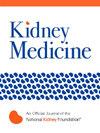美国有和没有肾脏疾病的成年人对流感、肺炎球菌、带状疱疹和COVID-19疫苗的摄取:来自2018-2022年行为风险因素监测系统的发现
IF 3.4
Q1 UROLOGY & NEPHROLOGY
引用次数: 0
摘要
理由和目的肾脏疾病患者有感染流感、肺炎、带状疱疹和2019冠状病毒(COVID-19)等疾病的风险,这些疾病可以通过接种疫苗来预防。然而,这些疫苗在患有和不患有肾脏疾病的人群中的比较摄取情况尚未得到很好的描述。研究设计:横断面分析。2018-2022年行为风险因素监测系统(BRFSS)中符合接种疫苗条件的成年人。自我报告的肾脏疾病状况。接种流感(过去12个月)、肺炎球菌(终生)、带状疱疹(终生)和COVID-19(至少一剂)疫苗。分析方法:采用多变量logistic回归比较肾脏疾病患者和非肾脏疾病患者接种疫苗的几率。结果汇总显示了2018年至2022年的总体摄取情况,但COVID-19疫苗除外,该疫苗的数据仅为2022年。结果2018-2022年BRFSS合并样本中,4.0%患有肾脏疾病。在肾病患者中,COVID-19疫苗的吸收率最高(87.0%),其次是肺炎球菌(63.6%)、流感(59.6%)和带状疱疹(37.1%)疫苗。与没有肾脏疾病的人相比,这些数字更高(COVID-19为78.4%,肺炎球菌为52.9%,流感为41.8%,带状疱疹疫苗为31.1%),但差异因疫苗类型而异。在多变量logistic模型中,肺炎球菌疫苗与非肾脏疾病患者的比值比最大(aOR, 1.58 [95%CI, 1.48-1.69]),其次是COVID-19疫苗(1.50[1.18-1.89])、流感疫苗(1.35[1.28-1.43])和带状疱疹疫苗(1.03[0.91-1.17])。这些发现在不同年龄和种族/民族群体中是一致的,通常在年轻人(相对于老年人)和非西班牙裔非洲裔美国人和西班牙裔(相对于非西班牙裔白人)参与者中摄入量较低。局限性:自述可能导致肾脏疾病状态的错误分类。结论肾脏疾病患者的疫苗吸收量因疫苗类型而异,但仍处于次优状态,特别是带状疱疹疫苗。需要努力提高疫苗的吸收率,并确保向肾病患者提供所有推荐的疫苗。患有肾脏疾病的人更容易感染流感、肺炎、带状疱疹和2019冠状病毒,但疫苗可以帮助预防这些疾病。这项研究利用行为风险因素监测系统的数据,研究了2018年至2022年有多少患有和没有肾脏疾病的成年人接种了这些疫苗。患有肾脏疾病的人更有可能接种疫苗,尤其是2019冠状病毒(87%)和肺炎(64%)。然而,只有37%的人接种了带状疱疹疫苗。年轻人、非裔美国人或西班牙裔美国人的疫苗接种率普遍较低。这项研究表明,需要做出更多的努力来提高肾脏疾病患者的疫苗吸收率,尤其是带状疱疹疫苗。本文章由计算机程序翻译,如有差异,请以英文原文为准。
The Uptake of Influenza, Pneumococcal, Shingles, and COVID-19 Vaccines Among US Adults With and Without Kidney Disease: Findings From the Behavioral Risk Factor Surveillance System 2018-2022
Rationale & Objective
Persons with kidney disease are at risk of infections such as influenza, pneumonia, shingles, and coronavirus-2019 (COVID-19), which can be prevented by vaccination. However, comparative uptake across these vaccines in people with and without kidney disease has not been well described.
Study Design
A cross-sectional analysis.
Setting & Participants
Vaccine-eligible adults in the Behavioral Risk Factor Surveillance System (BRFSS) 2018-2022.
Exposures
Self-reported status of kidney disease.
Outcomes
The uptake of the influenza (past 12 months), pneumococcal (lifetime), shingles (lifetime), and COVID-19 (at least one dose) vaccines.
Analytical Approach
Multivariable logistic regressions to compare the odds of vaccine uptake between those with and without kidney disease. The results were pooled to show the overall uptake from 2018 to 2022, except for the COVID-19 vaccine, for which data were only available for 2022.
Results
In the pooled sample of BRFSS 2018-2022, 4.0% had kidney disease. In people with kidney disease, the highest uptake was observed for COVID-19 (87.0%), followed by pneumococcal (63.6%), influenza (59.6%), and shingles (37.1%) vaccines. These numbers were higher compared with those without kidney disease (78.4% for COVID-19, 52.9% for pneumococcal, 41.8% for influenza, and 31.1% for shingles vaccines), but the differences varied by vaccine type. In multivariable logistic models, the largest odds ratio in uptake of those with versus without kidney disease was observed for pneumococcal vaccine (aOR, 1.58 [95%CI, 1.48-1.69]), followed by COVID-19 (1.50 [1.18-1.89]), influenza (1.35 [1.28-1.43]), and shingles (1.03 [0.91-1.17]) vaccines. These findings were consistent across age and race/ethnicity groups, with lower uptakes generally in younger (vs older) and non-Hispanic African American and Hispanic (vs non-Hispanic White) participants.
Limitations
Possible misclassification of kidney disease status due to self-report.
Conclusions
Vaccine uptakes in people with kidney disease varied by vaccine type and remained suboptimal, particularly for shingles vaccine. Efforts are needed to increase vaccine uptake and ensure all recommended vaccines are offered to people with kidney disease.
Plain-Language Summary
People with kidney disease are more likely to get sick from infections such as the flu, pneumonia, shingles, and coronavirus-2019, but vaccines can help prevent these illnesses. This study looked at how many adults with and without kidney disease got these vaccines from 2018 to 2022 using Behavioral Risk Factor Surveillance System data. People with kidney disease were more likely to get vaccinated, especially for coronavirus-2019 (87%) and pneumonia (64%). However, only 37% got the shingles vaccine. Vaccination rates were generally lower for younger people and those who were African American or Hispanic. The study suggests that more efforts are needed to improve vaccine uptake in people with kidney disease, especially for the shingles vaccine.
求助全文
通过发布文献求助,成功后即可免费获取论文全文。
去求助

 求助内容:
求助内容: 应助结果提醒方式:
应助结果提醒方式:


